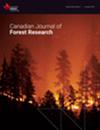先前遮蔽的红云杉的暂时变薄冲击
IF 1.5
3区 农林科学
Q2 FORESTRY
引用次数: 1
摘要
造林间伐可导致残留树木的快速小气候变化。尽管竞争减少有好处,但间伐可能会引起“间伐冲击”——树木在适应新环境时的暂时负面生理反应。我们研究了相对于未修剪的对照,间伐对残余的、先前遮蔽的红杉(Picea rubens Sarg.)树木的小气候和生理的影响。日最高温度和蒸汽压差均在减薄后增加,在较热和较干的日子中增加较大。为了应对这些环境变化,我们发现了明显的生理衰退证据。在间伐后1.7周,我们发现相对于对照树,平均正午水势降低了0.59 mpa,持续了1.4周。因此,疏林处理的树木等于或超过发表的针胀损失估计值。间伐两周后,当年针的光合效率下降3.8%,在剩余的生长季节中,每周下降1.3%。这些结果表明,减薄冲击发生在红杉中,这是一种适应阴影的气候敏感物种。减薄冲击可能导致通常观察到的减薄后的滞后生长响应,这些影响在未来新的气候条件下可能更加极端。本文章由计算机程序翻译,如有差异,请以英文原文为准。
Temporary thinning shock in previously shaded red spruce
Silvicultural thinning can lead to rapid microclimatic changes for residual trees. Despite the benefits of decreased competition, thinning may induce “thinning shock” – temporary negative physiological responses as trees acclimate to new conditions. We examined the impact of thinning on the microclimate and physiology of residual, previously shaded red spruce (Picea rubens Sarg.) trees relative to non-thinned controls. Both daily maximum temperature and vapor pressure deficit increased post thinning, with larger increases observed on hotter and drier days. In response to these environmental changes, we found clear evidence of physiological declines. At 1.7 weeks post thinning, we found a 0.59-MPa reduction in average midday water potential relative to control trees, which lasted for an additional 1.4 weeks. Thus, the trees in the thinning treatment were at or beyond published estimates of needle turgor loss. Thinning decreased photosynthetic efficiency of current-year needles 3.8% after two weeks, and it declined by 1.3% per week for the remainder of the growing season. These results suggest that thinning shock occurs in red spruce, a shade-adapted, climate-sensitive species. Thinning shock may contribute to the lagged growth responses commonly observed post thinning, and these effects may be more extreme in novel future climates.
求助全文
通过发布文献求助,成功后即可免费获取论文全文。
去求助
来源期刊
CiteScore
4.20
自引率
9.10%
发文量
109
审稿时长
3 months
期刊介绍:
Published since 1971, the Canadian Journal of Forest Research is a monthly journal that features articles, reviews, notes and concept papers on a broad spectrum of forest sciences, including biometrics, conservation, disturbances, ecology, economics, entomology, genetics, hydrology, management, nutrient cycling, pathology, physiology, remote sensing, silviculture, social sciences, soils, stand dynamics, and wood science, all in relation to the understanding or management of ecosystem services. It also publishes special issues dedicated to a topic of current interest.

 求助内容:
求助内容: 应助结果提醒方式:
应助结果提醒方式:


